Research Report: Assessing Urban Tourism Prospects in Cambridge
VerifiedAdded on 2020/10/22
|25
|5347
|136
Report
AI Summary
This report investigates the possibilities of urban tourism in Cambridge City. It begins with an overview of urban tourism, its background, and an introduction to Cambridge. The research aims to identify and assess Cambridge's urban tourism potential, exploring its key attractions such as Cambridge University, museums, and historical sites. The report reviews relevant literature on urban tourism, examines research methodology including qualitative and quantitative approaches, data analysis, and ethical considerations. The study aims to determine the processes used by Cambridge to attract visitors, identify the importance of travelers, examine the nature of offered products, and determine marketing features of urban areas. The report concludes with findings, recommendations, and references, providing insights into the city's tourism landscape and opportunities for future development.
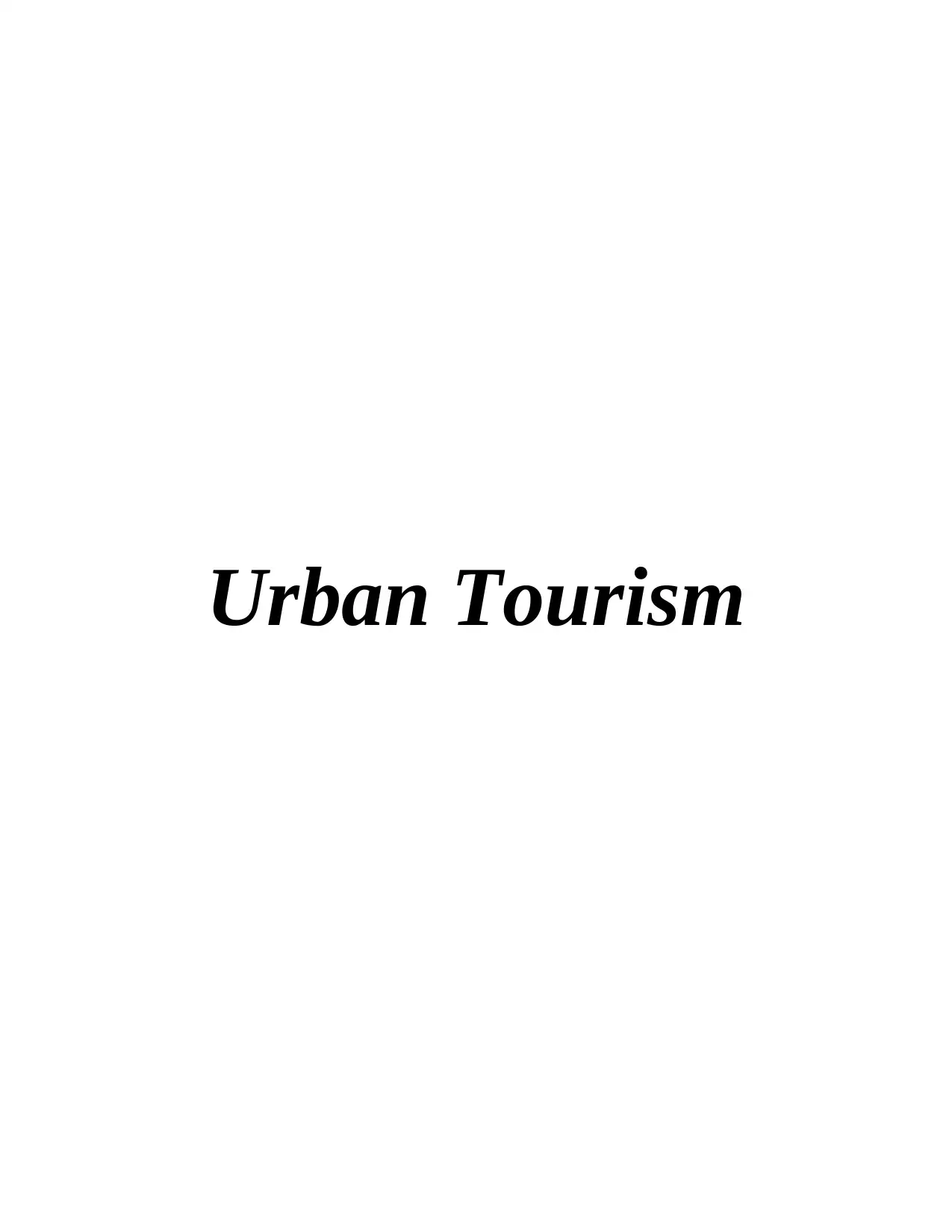
Urban Tourism
Paraphrase This Document
Need a fresh take? Get an instant paraphrase of this document with our AI Paraphraser
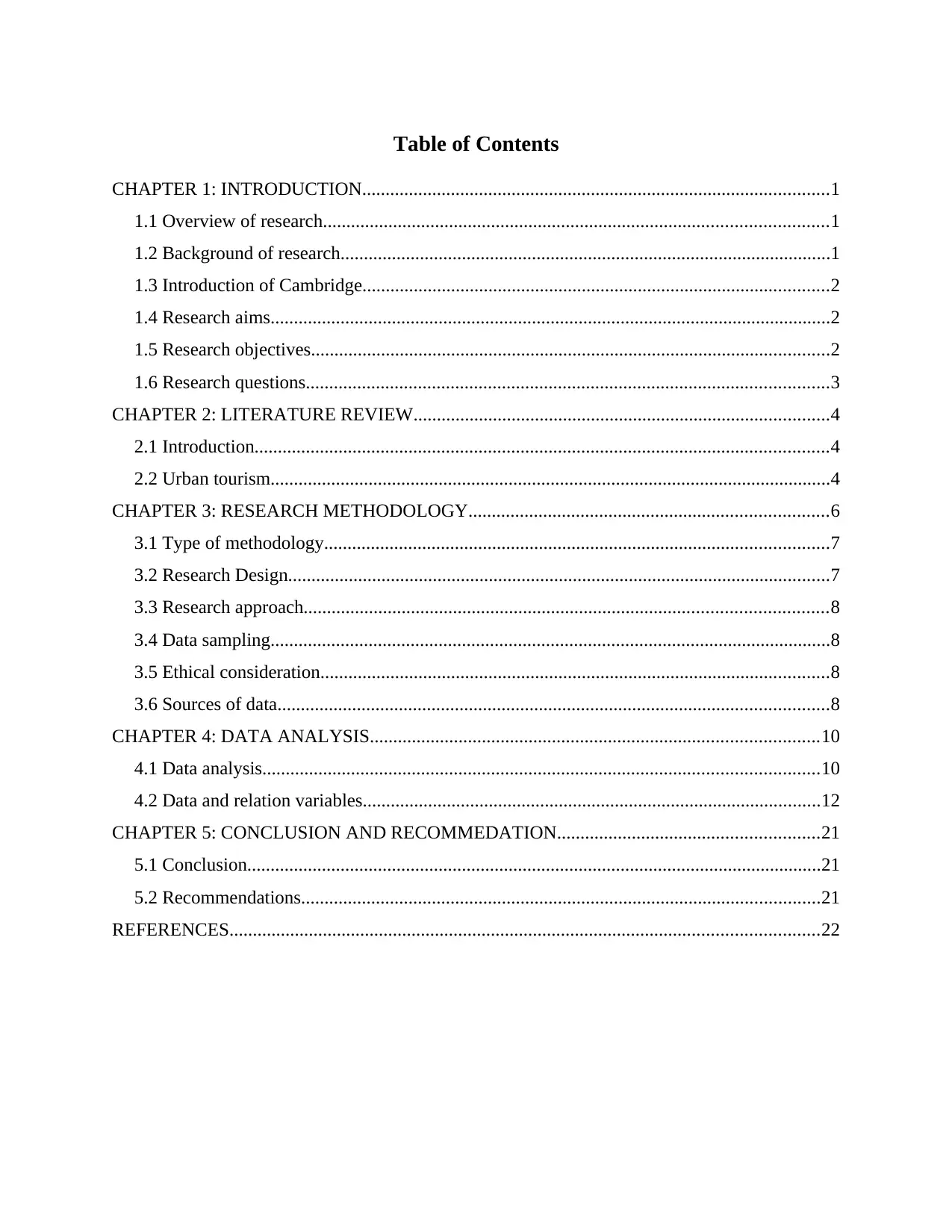
Table of Contents
CHAPTER 1: INTRODUCTION....................................................................................................1
1.1 Overview of research............................................................................................................1
1.2 Background of research.........................................................................................................1
1.3 Introduction of Cambridge....................................................................................................2
1.4 Research aims........................................................................................................................2
1.5 Research objectives...............................................................................................................2
1.6 Research questions................................................................................................................3
CHAPTER 2: LITERATURE REVIEW.........................................................................................4
2.1 Introduction...........................................................................................................................4
2.2 Urban tourism........................................................................................................................4
CHAPTER 3: RESEARCH METHODOLOGY.............................................................................6
3.1 Type of methodology............................................................................................................7
3.2 Research Design....................................................................................................................7
3.3 Research approach................................................................................................................8
3.4 Data sampling........................................................................................................................8
3.5 Ethical consideration.............................................................................................................8
3.6 Sources of data......................................................................................................................8
CHAPTER 4: DATA ANALYSIS................................................................................................10
4.1 Data analysis.......................................................................................................................10
4.2 Data and relation variables..................................................................................................12
CHAPTER 5: CONCLUSION AND RECOMMEDATION........................................................21
5.1 Conclusion...........................................................................................................................21
5.2 Recommendations...............................................................................................................21
REFERENCES..............................................................................................................................22
CHAPTER 1: INTRODUCTION....................................................................................................1
1.1 Overview of research............................................................................................................1
1.2 Background of research.........................................................................................................1
1.3 Introduction of Cambridge....................................................................................................2
1.4 Research aims........................................................................................................................2
1.5 Research objectives...............................................................................................................2
1.6 Research questions................................................................................................................3
CHAPTER 2: LITERATURE REVIEW.........................................................................................4
2.1 Introduction...........................................................................................................................4
2.2 Urban tourism........................................................................................................................4
CHAPTER 3: RESEARCH METHODOLOGY.............................................................................6
3.1 Type of methodology............................................................................................................7
3.2 Research Design....................................................................................................................7
3.3 Research approach................................................................................................................8
3.4 Data sampling........................................................................................................................8
3.5 Ethical consideration.............................................................................................................8
3.6 Sources of data......................................................................................................................8
CHAPTER 4: DATA ANALYSIS................................................................................................10
4.1 Data analysis.......................................................................................................................10
4.2 Data and relation variables..................................................................................................12
CHAPTER 5: CONCLUSION AND RECOMMEDATION........................................................21
5.1 Conclusion...........................................................................................................................21
5.2 Recommendations...............................................................................................................21
REFERENCES..............................................................................................................................22

⊘ This is a preview!⊘
Do you want full access?
Subscribe today to unlock all pages.

Trusted by 1+ million students worldwide
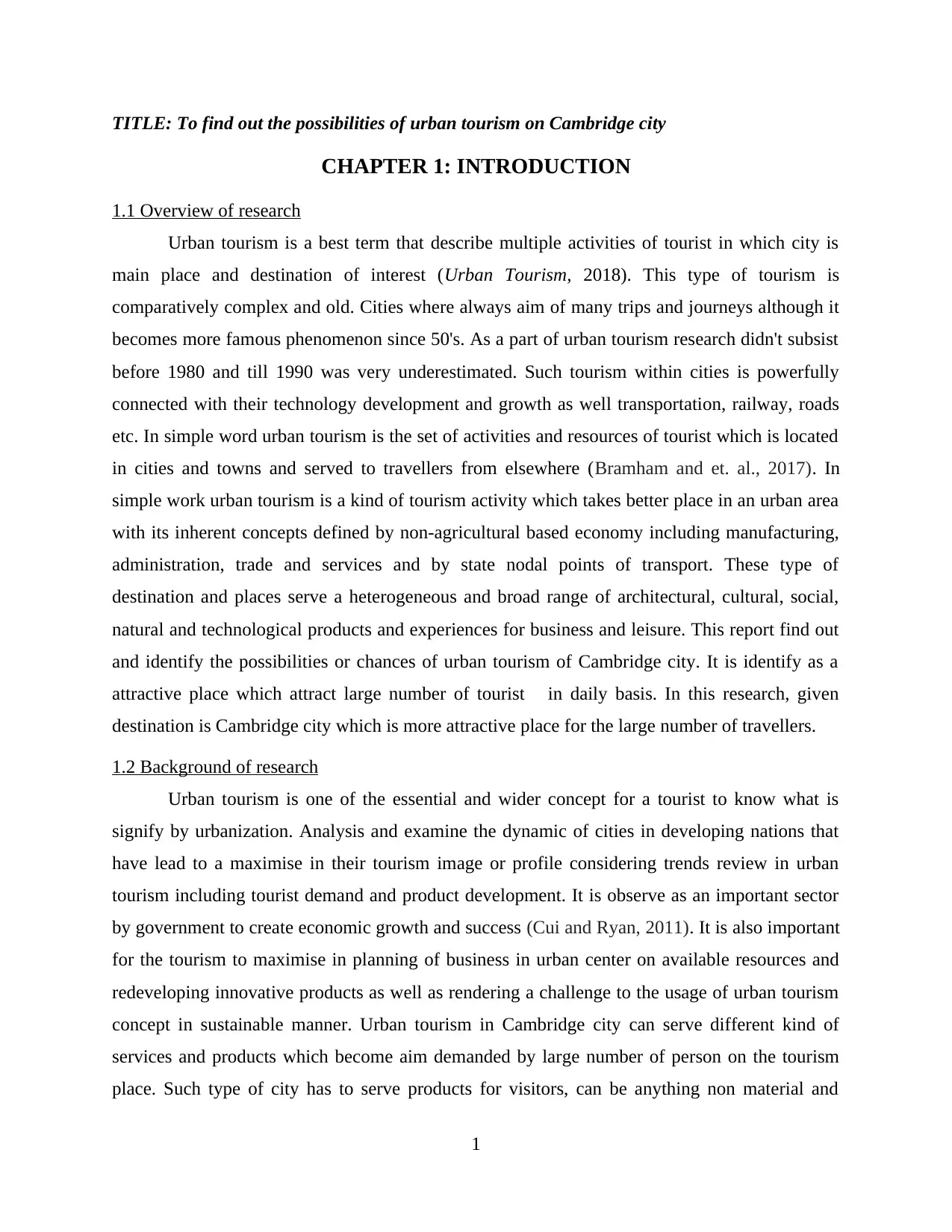
TITLE: To find out the possibilities of urban tourism on Cambridge city
CHAPTER 1: INTRODUCTION
1.1 Overview of research
Urban tourism is a best term that describe multiple activities of tourist in which city is
main place and destination of interest (Urban Tourism, 2018). This type of tourism is
comparatively complex and old. Cities where always aim of many trips and journeys although it
becomes more famous phenomenon since 50's. As a part of urban tourism research didn't subsist
before 1980 and till 1990 was very underestimated. Such tourism within cities is powerfully
connected with their technology development and growth as well transportation, railway, roads
etc. In simple word urban tourism is the set of activities and resources of tourist which is located
in cities and towns and served to travellers from elsewhere (Bramham and et. al., 2017). In
simple work urban tourism is a kind of tourism activity which takes better place in an urban area
with its inherent concepts defined by non-agricultural based economy including manufacturing,
administration, trade and services and by state nodal points of transport. These type of
destination and places serve a heterogeneous and broad range of architectural, cultural, social,
natural and technological products and experiences for business and leisure. This report find out
and identify the possibilities or chances of urban tourism of Cambridge city. It is identify as a
attractive place which attract large number of tourist in daily basis. In this research, given
destination is Cambridge city which is more attractive place for the large number of travellers.
1.2 Background of research
Urban tourism is one of the essential and wider concept for a tourist to know what is
signify by urbanization. Analysis and examine the dynamic of cities in developing nations that
have lead to a maximise in their tourism image or profile considering trends review in urban
tourism including tourist demand and product development. It is observe as an important sector
by government to create economic growth and success (Cui and Ryan, 2011). It is also important
for the tourism to maximise in planning of business in urban center on available resources and
redeveloping innovative products as well as rendering a challenge to the usage of urban tourism
concept in sustainable manner. Urban tourism in Cambridge city can serve different kind of
services and products which become aim demanded by large number of person on the tourism
place. Such type of city has to serve products for visitors, can be anything non material and
1
CHAPTER 1: INTRODUCTION
1.1 Overview of research
Urban tourism is a best term that describe multiple activities of tourist in which city is
main place and destination of interest (Urban Tourism, 2018). This type of tourism is
comparatively complex and old. Cities where always aim of many trips and journeys although it
becomes more famous phenomenon since 50's. As a part of urban tourism research didn't subsist
before 1980 and till 1990 was very underestimated. Such tourism within cities is powerfully
connected with their technology development and growth as well transportation, railway, roads
etc. In simple word urban tourism is the set of activities and resources of tourist which is located
in cities and towns and served to travellers from elsewhere (Bramham and et. al., 2017). In
simple work urban tourism is a kind of tourism activity which takes better place in an urban area
with its inherent concepts defined by non-agricultural based economy including manufacturing,
administration, trade and services and by state nodal points of transport. These type of
destination and places serve a heterogeneous and broad range of architectural, cultural, social,
natural and technological products and experiences for business and leisure. This report find out
and identify the possibilities or chances of urban tourism of Cambridge city. It is identify as a
attractive place which attract large number of tourist in daily basis. In this research, given
destination is Cambridge city which is more attractive place for the large number of travellers.
1.2 Background of research
Urban tourism is one of the essential and wider concept for a tourist to know what is
signify by urbanization. Analysis and examine the dynamic of cities in developing nations that
have lead to a maximise in their tourism image or profile considering trends review in urban
tourism including tourist demand and product development. It is observe as an important sector
by government to create economic growth and success (Cui and Ryan, 2011). It is also important
for the tourism to maximise in planning of business in urban center on available resources and
redeveloping innovative products as well as rendering a challenge to the usage of urban tourism
concept in sustainable manner. Urban tourism in Cambridge city can serve different kind of
services and products which become aim demanded by large number of person on the tourism
place. Such type of city has to serve products for visitors, can be anything non material and
1
Paraphrase This Document
Need a fresh take? Get an instant paraphrase of this document with our AI Paraphraser
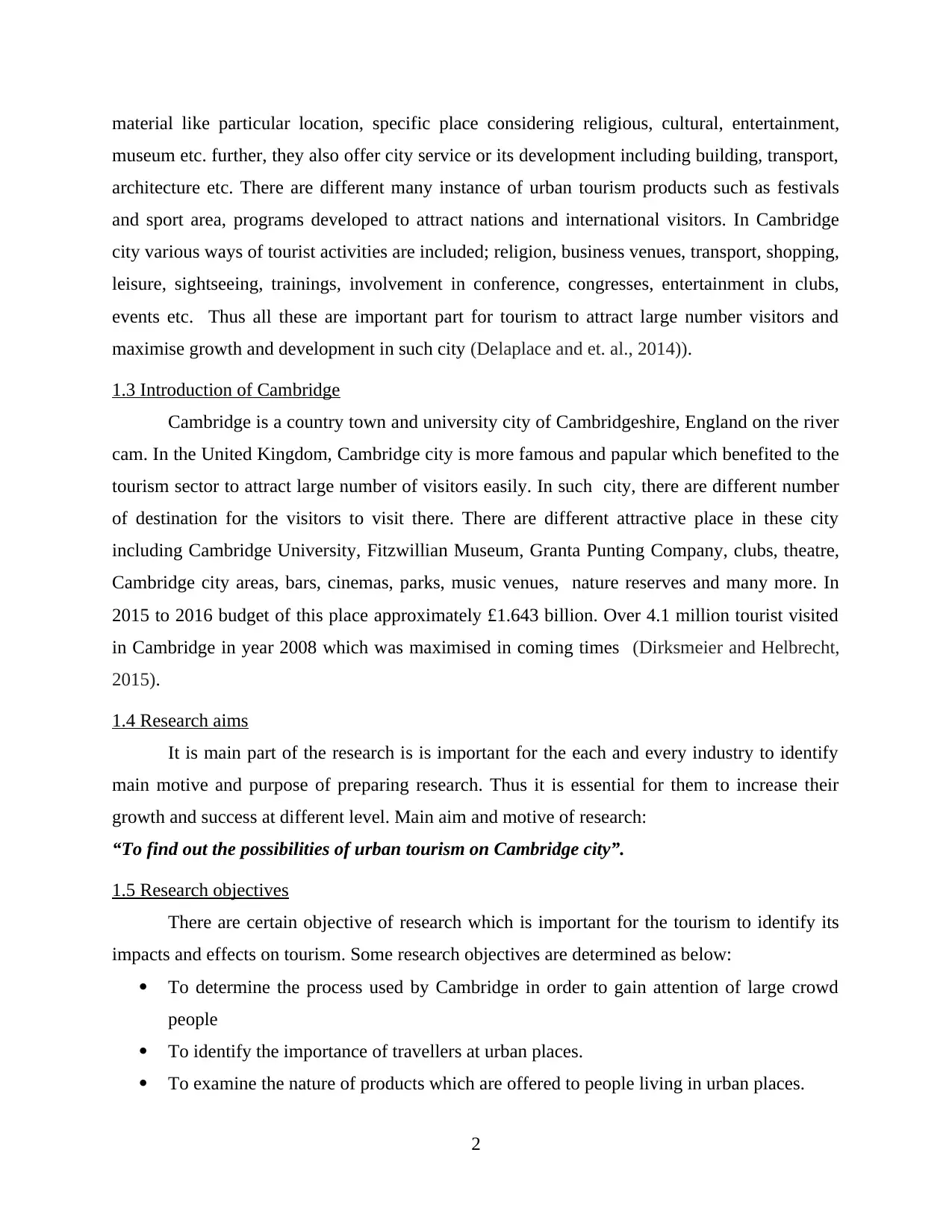
material like particular location, specific place considering religious, cultural, entertainment,
museum etc. further, they also offer city service or its development including building, transport,
architecture etc. There are different many instance of urban tourism products such as festivals
and sport area, programs developed to attract nations and international visitors. In Cambridge
city various ways of tourist activities are included; religion, business venues, transport, shopping,
leisure, sightseeing, trainings, involvement in conference, congresses, entertainment in clubs,
events etc. Thus all these are important part for tourism to attract large number visitors and
maximise growth and development in such city (Delaplace and et. al., 2014)).
1.3 Introduction of Cambridge
Cambridge is a country town and university city of Cambridgeshire, England on the river
cam. In the United Kingdom, Cambridge city is more famous and papular which benefited to the
tourism sector to attract large number of visitors easily. In such city, there are different number
of destination for the visitors to visit there. There are different attractive place in these city
including Cambridge University, Fitzwillian Museum, Granta Punting Company, clubs, theatre,
Cambridge city areas, bars, cinemas, parks, music venues, nature reserves and many more. In
2015 to 2016 budget of this place approximately £1.643 billion. Over 4.1 million tourist visited
in Cambridge in year 2008 which was maximised in coming times (Dirksmeier and Helbrecht,
2015).
1.4 Research aims
It is main part of the research is is important for the each and every industry to identify
main motive and purpose of preparing research. Thus it is essential for them to increase their
growth and success at different level. Main aim and motive of research:
“To find out the possibilities of urban tourism on Cambridge city”.
1.5 Research objectives
There are certain objective of research which is important for the tourism to identify its
impacts and effects on tourism. Some research objectives are determined as below:
To determine the process used by Cambridge in order to gain attention of large crowd
people
To identify the importance of travellers at urban places.
To examine the nature of products which are offered to people living in urban places.
2
museum etc. further, they also offer city service or its development including building, transport,
architecture etc. There are different many instance of urban tourism products such as festivals
and sport area, programs developed to attract nations and international visitors. In Cambridge
city various ways of tourist activities are included; religion, business venues, transport, shopping,
leisure, sightseeing, trainings, involvement in conference, congresses, entertainment in clubs,
events etc. Thus all these are important part for tourism to attract large number visitors and
maximise growth and development in such city (Delaplace and et. al., 2014)).
1.3 Introduction of Cambridge
Cambridge is a country town and university city of Cambridgeshire, England on the river
cam. In the United Kingdom, Cambridge city is more famous and papular which benefited to the
tourism sector to attract large number of visitors easily. In such city, there are different number
of destination for the visitors to visit there. There are different attractive place in these city
including Cambridge University, Fitzwillian Museum, Granta Punting Company, clubs, theatre,
Cambridge city areas, bars, cinemas, parks, music venues, nature reserves and many more. In
2015 to 2016 budget of this place approximately £1.643 billion. Over 4.1 million tourist visited
in Cambridge in year 2008 which was maximised in coming times (Dirksmeier and Helbrecht,
2015).
1.4 Research aims
It is main part of the research is is important for the each and every industry to identify
main motive and purpose of preparing research. Thus it is essential for them to increase their
growth and success at different level. Main aim and motive of research:
“To find out the possibilities of urban tourism on Cambridge city”.
1.5 Research objectives
There are certain objective of research which is important for the tourism to identify its
impacts and effects on tourism. Some research objectives are determined as below:
To determine the process used by Cambridge in order to gain attention of large crowd
people
To identify the importance of travellers at urban places.
To examine the nature of products which are offered to people living in urban places.
2
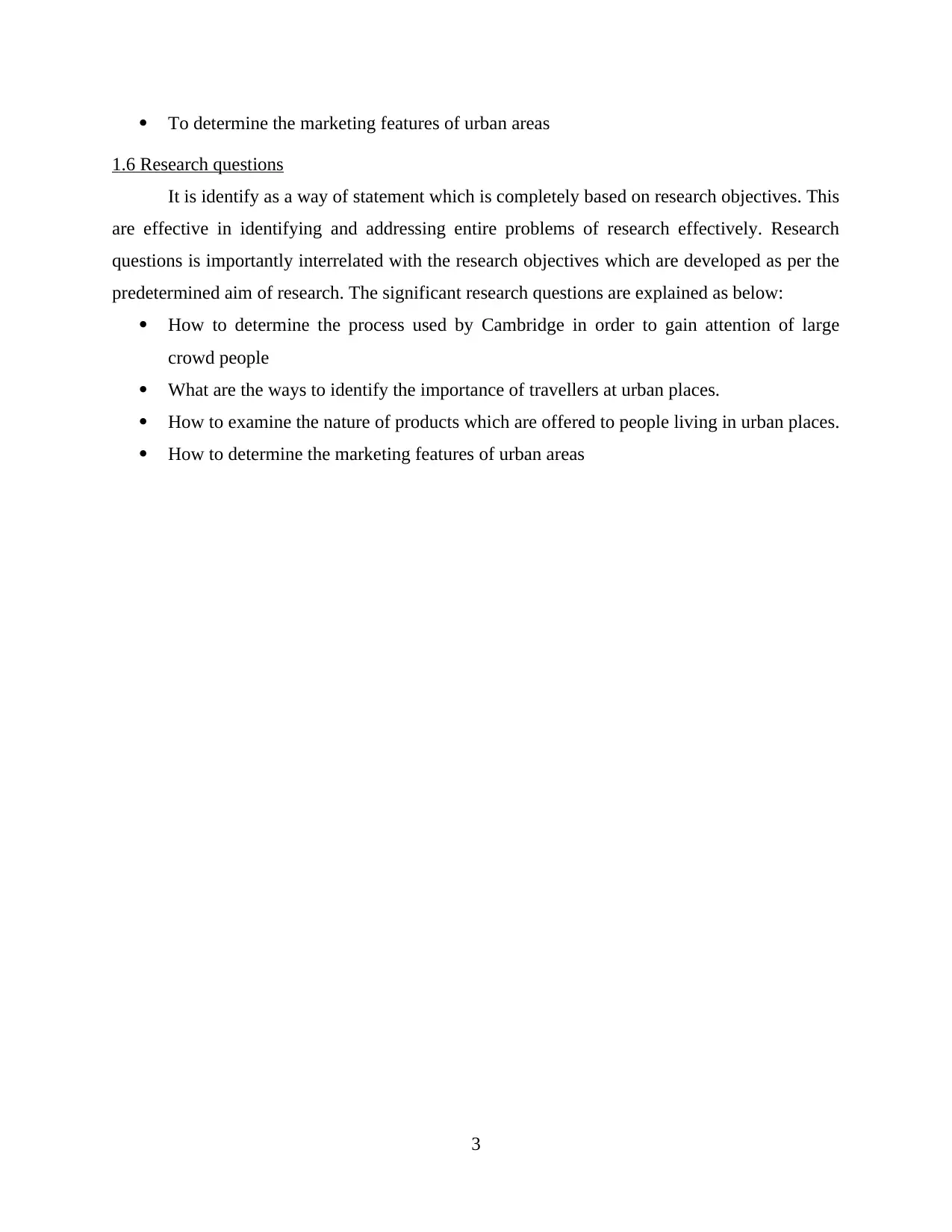
To determine the marketing features of urban areas
1.6 Research questions
It is identify as a way of statement which is completely based on research objectives. This
are effective in identifying and addressing entire problems of research effectively. Research
questions is importantly interrelated with the research objectives which are developed as per the
predetermined aim of research. The significant research questions are explained as below:
How to determine the process used by Cambridge in order to gain attention of large
crowd people
What are the ways to identify the importance of travellers at urban places.
How to examine the nature of products which are offered to people living in urban places.
How to determine the marketing features of urban areas
3
1.6 Research questions
It is identify as a way of statement which is completely based on research objectives. This
are effective in identifying and addressing entire problems of research effectively. Research
questions is importantly interrelated with the research objectives which are developed as per the
predetermined aim of research. The significant research questions are explained as below:
How to determine the process used by Cambridge in order to gain attention of large
crowd people
What are the ways to identify the importance of travellers at urban places.
How to examine the nature of products which are offered to people living in urban places.
How to determine the marketing features of urban areas
3
⊘ This is a preview!⊘
Do you want full access?
Subscribe today to unlock all pages.

Trusted by 1+ million students worldwide
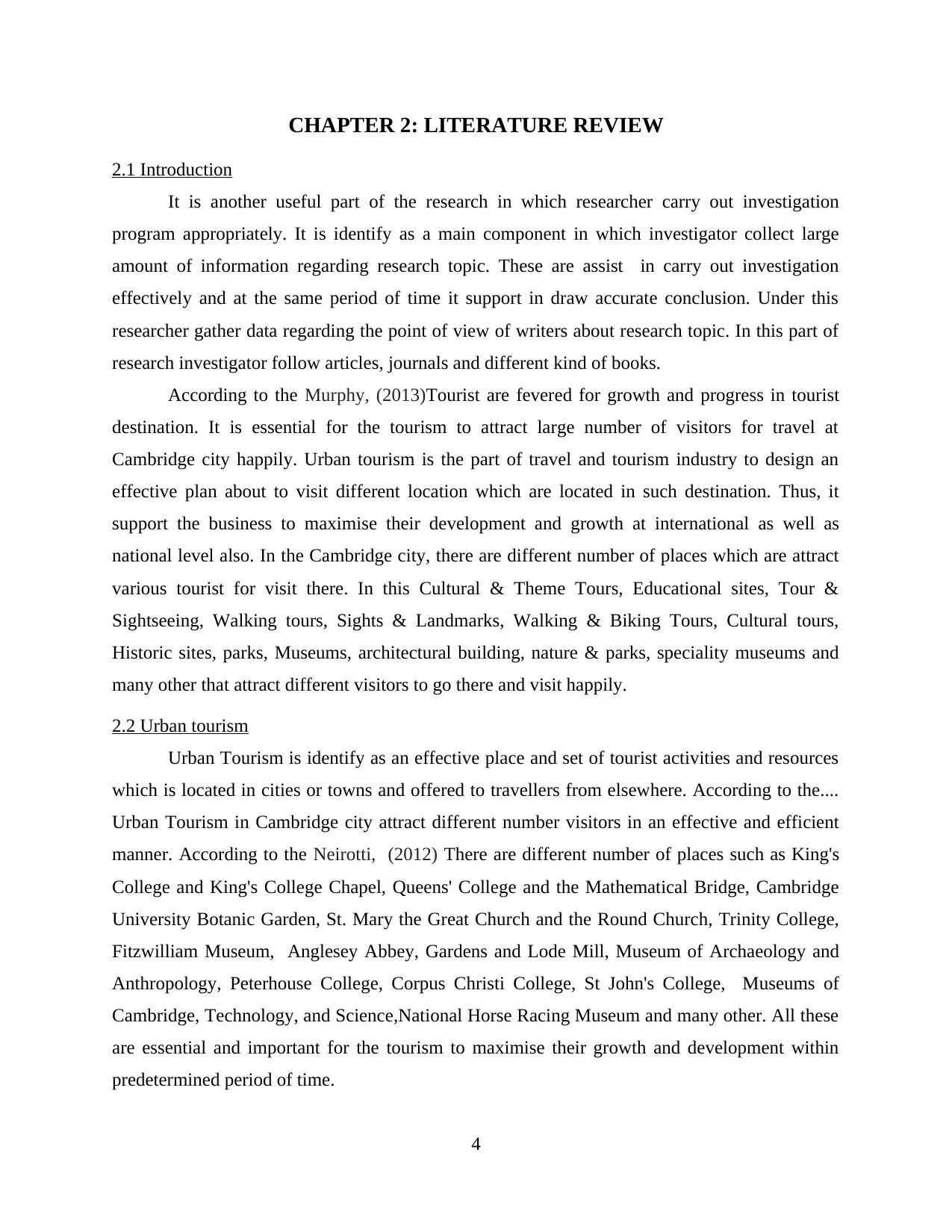
CHAPTER 2: LITERATURE REVIEW
2.1 Introduction
It is another useful part of the research in which researcher carry out investigation
program appropriately. It is identify as a main component in which investigator collect large
amount of information regarding research topic. These are assist in carry out investigation
effectively and at the same period of time it support in draw accurate conclusion. Under this
researcher gather data regarding the point of view of writers about research topic. In this part of
research investigator follow articles, journals and different kind of books.
According to the Murphy, (2013)Tourist are fevered for growth and progress in tourist
destination. It is essential for the tourism to attract large number of visitors for travel at
Cambridge city happily. Urban tourism is the part of travel and tourism industry to design an
effective plan about to visit different location which are located in such destination. Thus, it
support the business to maximise their development and growth at international as well as
national level also. In the Cambridge city, there are different number of places which are attract
various tourist for visit there. In this Cultural & Theme Tours, Educational sites, Tour &
Sightseeing, Walking tours, Sights & Landmarks, Walking & Biking Tours, Cultural tours,
Historic sites, parks, Museums, architectural building, nature & parks, speciality museums and
many other that attract different visitors to go there and visit happily.
2.2 Urban tourism
Urban Tourism is identify as an effective place and set of tourist activities and resources
which is located in cities or towns and offered to travellers from elsewhere. According to the....
Urban Tourism in Cambridge city attract different number visitors in an effective and efficient
manner. According to the Neirotti, (2012) There are different number of places such as King's
College and King's College Chapel, Queens' College and the Mathematical Bridge, Cambridge
University Botanic Garden, St. Mary the Great Church and the Round Church, Trinity College,
Fitzwilliam Museum, Anglesey Abbey, Gardens and Lode Mill, Museum of Archaeology and
Anthropology, Peterhouse College, Corpus Christi College, St John's College, Museums of
Cambridge, Technology, and Science,National Horse Racing Museum and many other. All these
are essential and important for the tourism to maximise their growth and development within
predetermined period of time.
4
2.1 Introduction
It is another useful part of the research in which researcher carry out investigation
program appropriately. It is identify as a main component in which investigator collect large
amount of information regarding research topic. These are assist in carry out investigation
effectively and at the same period of time it support in draw accurate conclusion. Under this
researcher gather data regarding the point of view of writers about research topic. In this part of
research investigator follow articles, journals and different kind of books.
According to the Murphy, (2013)Tourist are fevered for growth and progress in tourist
destination. It is essential for the tourism to attract large number of visitors for travel at
Cambridge city happily. Urban tourism is the part of travel and tourism industry to design an
effective plan about to visit different location which are located in such destination. Thus, it
support the business to maximise their development and growth at international as well as
national level also. In the Cambridge city, there are different number of places which are attract
various tourist for visit there. In this Cultural & Theme Tours, Educational sites, Tour &
Sightseeing, Walking tours, Sights & Landmarks, Walking & Biking Tours, Cultural tours,
Historic sites, parks, Museums, architectural building, nature & parks, speciality museums and
many other that attract different visitors to go there and visit happily.
2.2 Urban tourism
Urban Tourism is identify as an effective place and set of tourist activities and resources
which is located in cities or towns and offered to travellers from elsewhere. According to the....
Urban Tourism in Cambridge city attract different number visitors in an effective and efficient
manner. According to the Neirotti, (2012) There are different number of places such as King's
College and King's College Chapel, Queens' College and the Mathematical Bridge, Cambridge
University Botanic Garden, St. Mary the Great Church and the Round Church, Trinity College,
Fitzwilliam Museum, Anglesey Abbey, Gardens and Lode Mill, Museum of Archaeology and
Anthropology, Peterhouse College, Corpus Christi College, St John's College, Museums of
Cambridge, Technology, and Science,National Horse Racing Museum and many other. All these
are essential and important for the tourism to maximise their growth and development within
predetermined period of time.
4
Paraphrase This Document
Need a fresh take? Get an instant paraphrase of this document with our AI Paraphraser
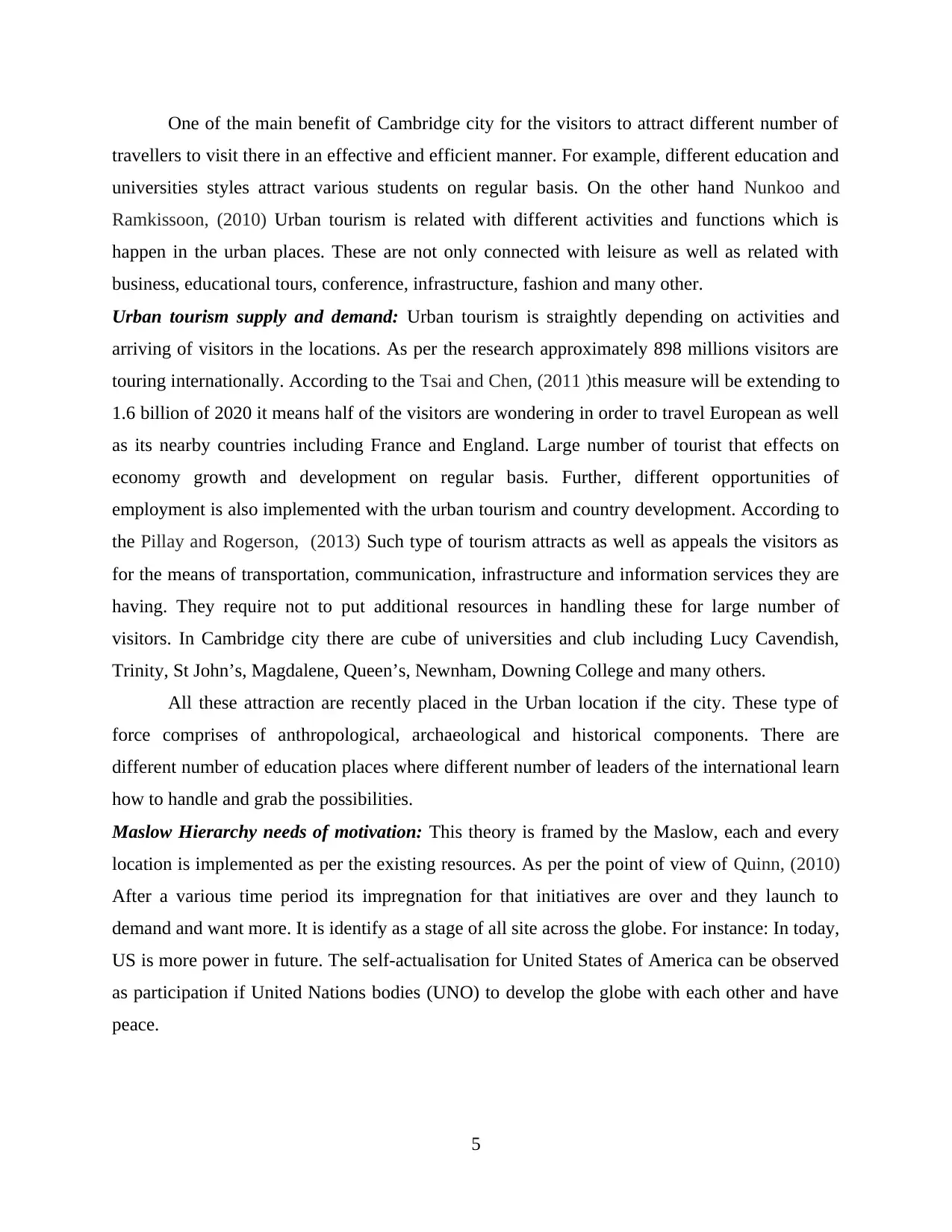
One of the main benefit of Cambridge city for the visitors to attract different number of
travellers to visit there in an effective and efficient manner. For example, different education and
universities styles attract various students on regular basis. On the other hand Nunkoo and
Ramkissoon, (2010) Urban tourism is related with different activities and functions which is
happen in the urban places. These are not only connected with leisure as well as related with
business, educational tours, conference, infrastructure, fashion and many other.
Urban tourism supply and demand: Urban tourism is straightly depending on activities and
arriving of visitors in the locations. As per the research approximately 898 millions visitors are
touring internationally. According to the Tsai and Chen, (2011 )this measure will be extending to
1.6 billion of 2020 it means half of the visitors are wondering in order to travel European as well
as its nearby countries including France and England. Large number of tourist that effects on
economy growth and development on regular basis. Further, different opportunities of
employment is also implemented with the urban tourism and country development. According to
the Pillay and Rogerson, (2013) Such type of tourism attracts as well as appeals the visitors as
for the means of transportation, communication, infrastructure and information services they are
having. They require not to put additional resources in handling these for large number of
visitors. In Cambridge city there are cube of universities and club including Lucy Cavendish,
Trinity, St John’s, Magdalene, Queen’s, Newnham, Downing College and many others.
All these attraction are recently placed in the Urban location if the city. These type of
force comprises of anthropological, archaeological and historical components. There are
different number of education places where different number of leaders of the international learn
how to handle and grab the possibilities.
Maslow Hierarchy needs of motivation: This theory is framed by the Maslow, each and every
location is implemented as per the existing resources. As per the point of view of Quinn, (2010)
After a various time period its impregnation for that initiatives are over and they launch to
demand and want more. It is identify as a stage of all site across the globe. For instance: In today,
US is more power in future. The self-actualisation for United States of America can be observed
as participation if United Nations bodies (UNO) to develop the globe with each other and have
peace.
5
travellers to visit there in an effective and efficient manner. For example, different education and
universities styles attract various students on regular basis. On the other hand Nunkoo and
Ramkissoon, (2010) Urban tourism is related with different activities and functions which is
happen in the urban places. These are not only connected with leisure as well as related with
business, educational tours, conference, infrastructure, fashion and many other.
Urban tourism supply and demand: Urban tourism is straightly depending on activities and
arriving of visitors in the locations. As per the research approximately 898 millions visitors are
touring internationally. According to the Tsai and Chen, (2011 )this measure will be extending to
1.6 billion of 2020 it means half of the visitors are wondering in order to travel European as well
as its nearby countries including France and England. Large number of tourist that effects on
economy growth and development on regular basis. Further, different opportunities of
employment is also implemented with the urban tourism and country development. According to
the Pillay and Rogerson, (2013) Such type of tourism attracts as well as appeals the visitors as
for the means of transportation, communication, infrastructure and information services they are
having. They require not to put additional resources in handling these for large number of
visitors. In Cambridge city there are cube of universities and club including Lucy Cavendish,
Trinity, St John’s, Magdalene, Queen’s, Newnham, Downing College and many others.
All these attraction are recently placed in the Urban location if the city. These type of
force comprises of anthropological, archaeological and historical components. There are
different number of education places where different number of leaders of the international learn
how to handle and grab the possibilities.
Maslow Hierarchy needs of motivation: This theory is framed by the Maslow, each and every
location is implemented as per the existing resources. As per the point of view of Quinn, (2010)
After a various time period its impregnation for that initiatives are over and they launch to
demand and want more. It is identify as a stage of all site across the globe. For instance: In today,
US is more power in future. The self-actualisation for United States of America can be observed
as participation if United Nations bodies (UNO) to develop the globe with each other and have
peace.
5
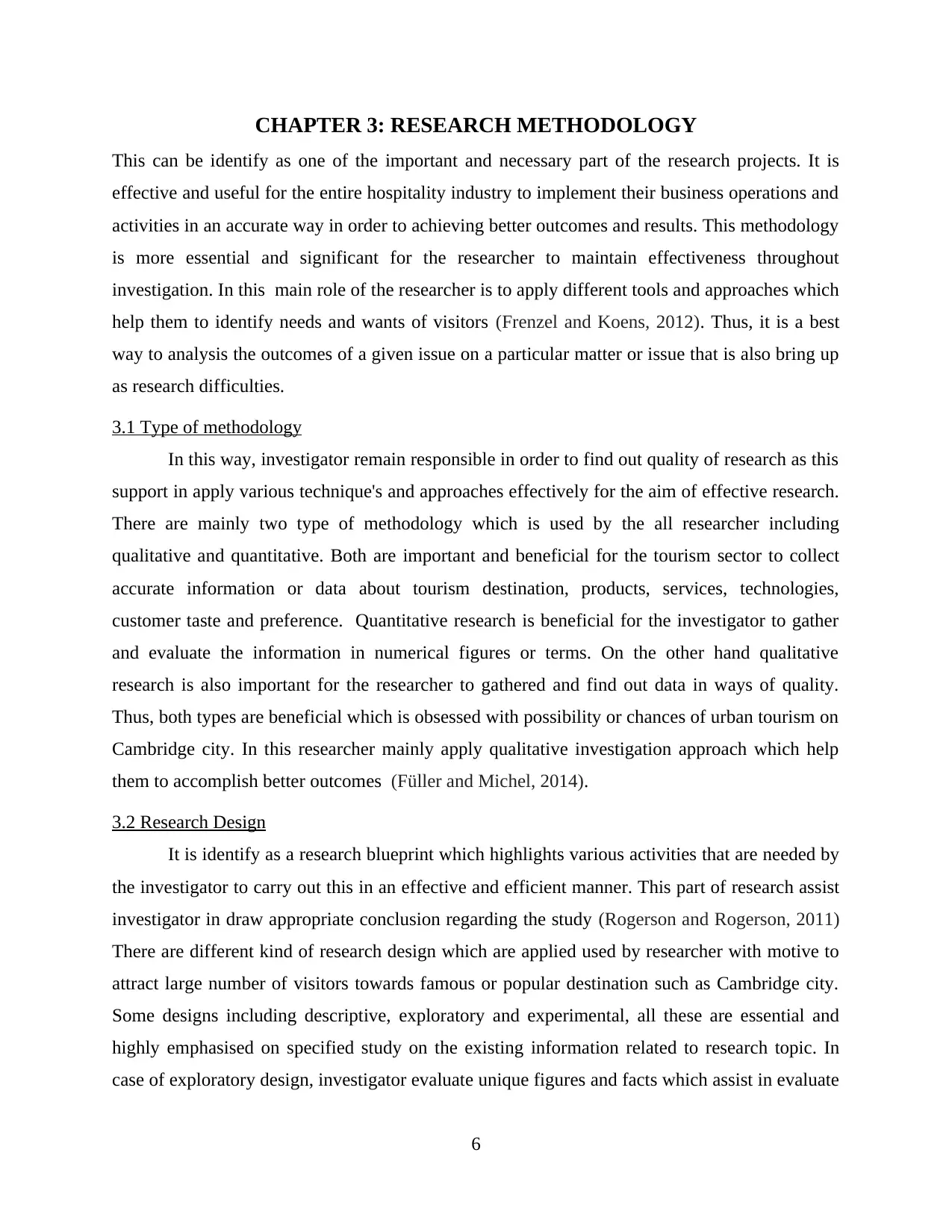
CHAPTER 3: RESEARCH METHODOLOGY
This can be identify as one of the important and necessary part of the research projects. It is
effective and useful for the entire hospitality industry to implement their business operations and
activities in an accurate way in order to achieving better outcomes and results. This methodology
is more essential and significant for the researcher to maintain effectiveness throughout
investigation. In this main role of the researcher is to apply different tools and approaches which
help them to identify needs and wants of visitors (Frenzel and Koens, 2012). Thus, it is a best
way to analysis the outcomes of a given issue on a particular matter or issue that is also bring up
as research difficulties.
3.1 Type of methodology
In this way, investigator remain responsible in order to find out quality of research as this
support in apply various technique's and approaches effectively for the aim of effective research.
There are mainly two type of methodology which is used by the all researcher including
qualitative and quantitative. Both are important and beneficial for the tourism sector to collect
accurate information or data about tourism destination, products, services, technologies,
customer taste and preference. Quantitative research is beneficial for the investigator to gather
and evaluate the information in numerical figures or terms. On the other hand qualitative
research is also important for the researcher to gathered and find out data in ways of quality.
Thus, both types are beneficial which is obsessed with possibility or chances of urban tourism on
Cambridge city. In this researcher mainly apply qualitative investigation approach which help
them to accomplish better outcomes (Füller and Michel, 2014).
3.2 Research Design
It is identify as a research blueprint which highlights various activities that are needed by
the investigator to carry out this in an effective and efficient manner. This part of research assist
investigator in draw appropriate conclusion regarding the study (Rogerson and Rogerson, 2011)
There are different kind of research design which are applied used by researcher with motive to
attract large number of visitors towards famous or popular destination such as Cambridge city.
Some designs including descriptive, exploratory and experimental, all these are essential and
highly emphasised on specified study on the existing information related to research topic. In
case of exploratory design, investigator evaluate unique figures and facts which assist in evaluate
6
This can be identify as one of the important and necessary part of the research projects. It is
effective and useful for the entire hospitality industry to implement their business operations and
activities in an accurate way in order to achieving better outcomes and results. This methodology
is more essential and significant for the researcher to maintain effectiveness throughout
investigation. In this main role of the researcher is to apply different tools and approaches which
help them to identify needs and wants of visitors (Frenzel and Koens, 2012). Thus, it is a best
way to analysis the outcomes of a given issue on a particular matter or issue that is also bring up
as research difficulties.
3.1 Type of methodology
In this way, investigator remain responsible in order to find out quality of research as this
support in apply various technique's and approaches effectively for the aim of effective research.
There are mainly two type of methodology which is used by the all researcher including
qualitative and quantitative. Both are important and beneficial for the tourism sector to collect
accurate information or data about tourism destination, products, services, technologies,
customer taste and preference. Quantitative research is beneficial for the investigator to gather
and evaluate the information in numerical figures or terms. On the other hand qualitative
research is also important for the researcher to gathered and find out data in ways of quality.
Thus, both types are beneficial which is obsessed with possibility or chances of urban tourism on
Cambridge city. In this researcher mainly apply qualitative investigation approach which help
them to accomplish better outcomes (Füller and Michel, 2014).
3.2 Research Design
It is identify as a research blueprint which highlights various activities that are needed by
the investigator to carry out this in an effective and efficient manner. This part of research assist
investigator in draw appropriate conclusion regarding the study (Rogerson and Rogerson, 2011)
There are different kind of research design which are applied used by researcher with motive to
attract large number of visitors towards famous or popular destination such as Cambridge city.
Some designs including descriptive, exploratory and experimental, all these are essential and
highly emphasised on specified study on the existing information related to research topic. In
case of exploratory design, investigator evaluate unique figures and facts which assist in evaluate
6
⊘ This is a preview!⊘
Do you want full access?
Subscribe today to unlock all pages.

Trusted by 1+ million students worldwide
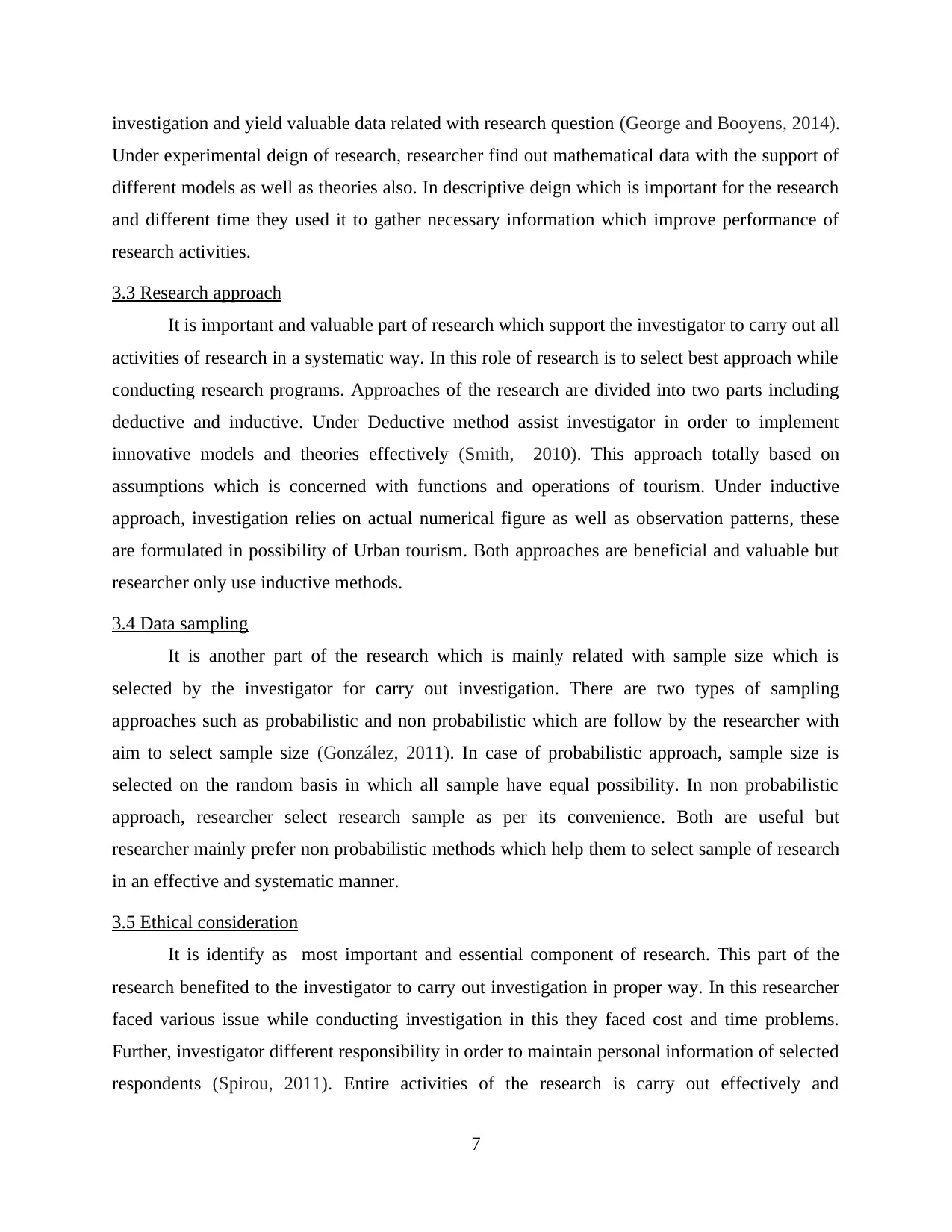
investigation and yield valuable data related with research question (George and Booyens, 2014).
Under experimental deign of research, researcher find out mathematical data with the support of
different models as well as theories also. In descriptive deign which is important for the research
and different time they used it to gather necessary information which improve performance of
research activities.
3.3 Research approach
It is important and valuable part of research which support the investigator to carry out all
activities of research in a systematic way. In this role of research is to select best approach while
conducting research programs. Approaches of the research are divided into two parts including
deductive and inductive. Under Deductive method assist investigator in order to implement
innovative models and theories effectively (Smith, 2010). This approach totally based on
assumptions which is concerned with functions and operations of tourism. Under inductive
approach, investigation relies on actual numerical figure as well as observation patterns, these
are formulated in possibility of Urban tourism. Both approaches are beneficial and valuable but
researcher only use inductive methods.
3.4 Data sampling
It is another part of the research which is mainly related with sample size which is
selected by the investigator for carry out investigation. There are two types of sampling
approaches such as probabilistic and non probabilistic which are follow by the researcher with
aim to select sample size (González, 2011). In case of probabilistic approach, sample size is
selected on the random basis in which all sample have equal possibility. In non probabilistic
approach, researcher select research sample as per its convenience. Both are useful but
researcher mainly prefer non probabilistic methods which help them to select sample of research
in an effective and systematic manner.
3.5 Ethical consideration
It is identify as most important and essential component of research. This part of the
research benefited to the investigator to carry out investigation in proper way. In this researcher
faced various issue while conducting investigation in this they faced cost and time problems.
Further, investigator different responsibility in order to maintain personal information of selected
respondents (Spirou, 2011). Entire activities of the research is carry out effectively and
7
Under experimental deign of research, researcher find out mathematical data with the support of
different models as well as theories also. In descriptive deign which is important for the research
and different time they used it to gather necessary information which improve performance of
research activities.
3.3 Research approach
It is important and valuable part of research which support the investigator to carry out all
activities of research in a systematic way. In this role of research is to select best approach while
conducting research programs. Approaches of the research are divided into two parts including
deductive and inductive. Under Deductive method assist investigator in order to implement
innovative models and theories effectively (Smith, 2010). This approach totally based on
assumptions which is concerned with functions and operations of tourism. Under inductive
approach, investigation relies on actual numerical figure as well as observation patterns, these
are formulated in possibility of Urban tourism. Both approaches are beneficial and valuable but
researcher only use inductive methods.
3.4 Data sampling
It is another part of the research which is mainly related with sample size which is
selected by the investigator for carry out investigation. There are two types of sampling
approaches such as probabilistic and non probabilistic which are follow by the researcher with
aim to select sample size (González, 2011). In case of probabilistic approach, sample size is
selected on the random basis in which all sample have equal possibility. In non probabilistic
approach, researcher select research sample as per its convenience. Both are useful but
researcher mainly prefer non probabilistic methods which help them to select sample of research
in an effective and systematic manner.
3.5 Ethical consideration
It is identify as most important and essential component of research. This part of the
research benefited to the investigator to carry out investigation in proper way. In this researcher
faced various issue while conducting investigation in this they faced cost and time problems.
Further, investigator different responsibility in order to maintain personal information of selected
respondents (Spirou, 2011). Entire activities of the research is carry out effectively and
7
Paraphrase This Document
Need a fresh take? Get an instant paraphrase of this document with our AI Paraphraser
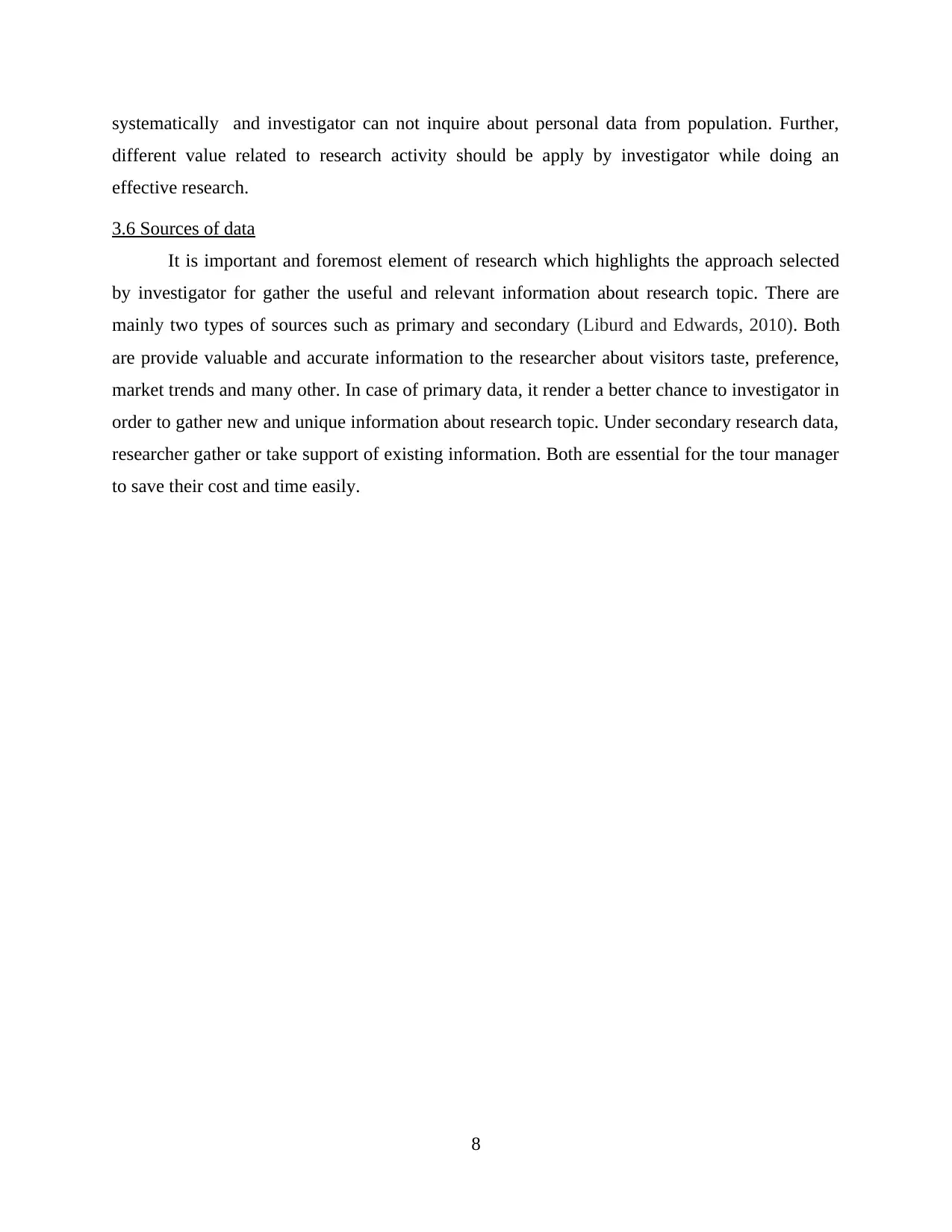
systematically and investigator can not inquire about personal data from population. Further,
different value related to research activity should be apply by investigator while doing an
effective research.
3.6 Sources of data
It is important and foremost element of research which highlights the approach selected
by investigator for gather the useful and relevant information about research topic. There are
mainly two types of sources such as primary and secondary (Liburd and Edwards, 2010). Both
are provide valuable and accurate information to the researcher about visitors taste, preference,
market trends and many other. In case of primary data, it render a better chance to investigator in
order to gather new and unique information about research topic. Under secondary research data,
researcher gather or take support of existing information. Both are essential for the tour manager
to save their cost and time easily.
8
different value related to research activity should be apply by investigator while doing an
effective research.
3.6 Sources of data
It is important and foremost element of research which highlights the approach selected
by investigator for gather the useful and relevant information about research topic. There are
mainly two types of sources such as primary and secondary (Liburd and Edwards, 2010). Both
are provide valuable and accurate information to the researcher about visitors taste, preference,
market trends and many other. In case of primary data, it render a better chance to investigator in
order to gather new and unique information about research topic. Under secondary research data,
researcher gather or take support of existing information. Both are essential for the tour manager
to save their cost and time easily.
8
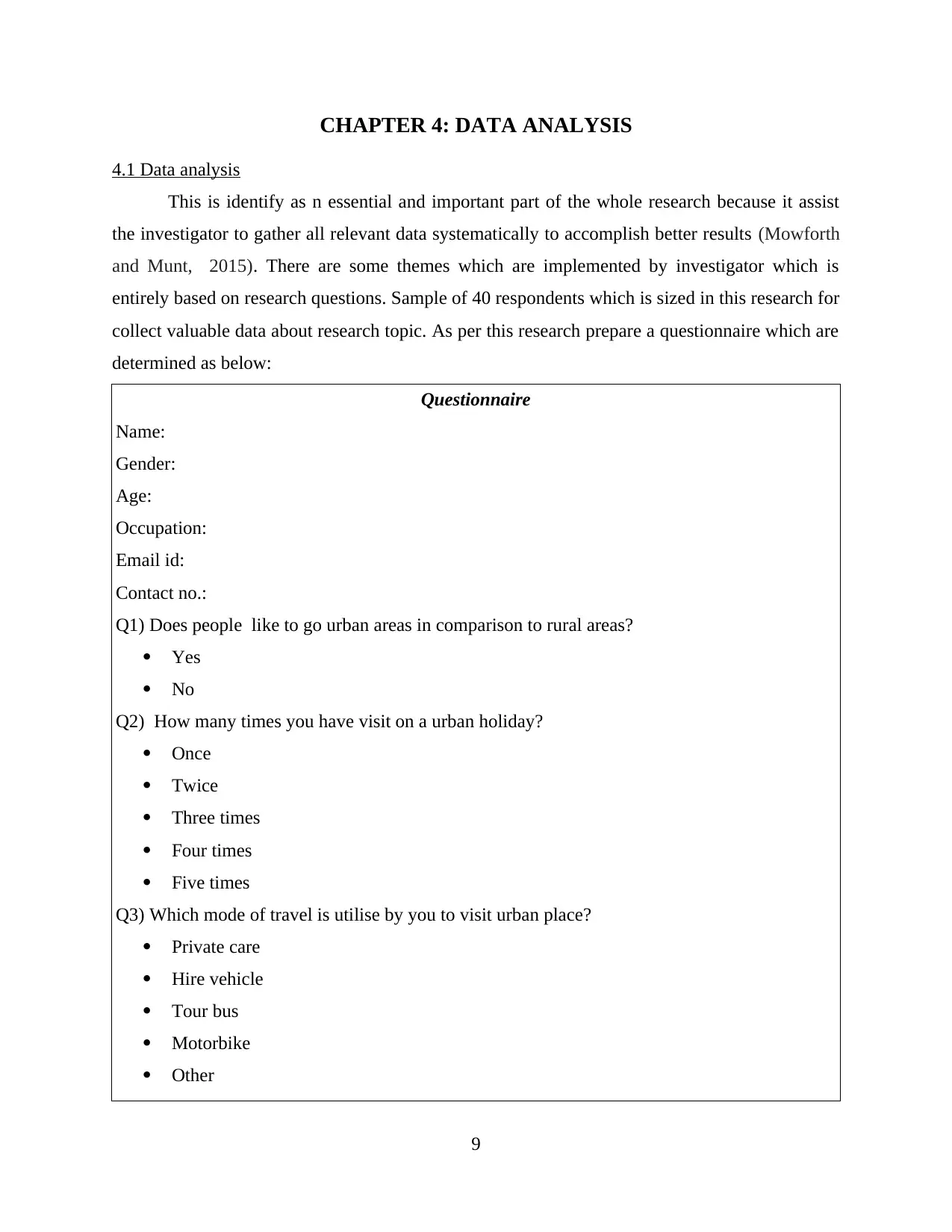
CHAPTER 4: DATA ANALYSIS
4.1 Data analysis
This is identify as n essential and important part of the whole research because it assist
the investigator to gather all relevant data systematically to accomplish better results (Mowforth
and Munt, 2015). There are some themes which are implemented by investigator which is
entirely based on research questions. Sample of 40 respondents which is sized in this research for
collect valuable data about research topic. As per this research prepare a questionnaire which are
determined as below:
Questionnaire
Name:
Gender:
Age:
Occupation:
Email id:
Contact no.:
Q1) Does people like to go urban areas in comparison to rural areas?
Yes
No
Q2) How many times you have visit on a urban holiday?
Once
Twice
Three times
Four times
Five times
Q3) Which mode of travel is utilise by you to visit urban place?
Private care
Hire vehicle
Tour bus
Motorbike
Other
9
4.1 Data analysis
This is identify as n essential and important part of the whole research because it assist
the investigator to gather all relevant data systematically to accomplish better results (Mowforth
and Munt, 2015). There are some themes which are implemented by investigator which is
entirely based on research questions. Sample of 40 respondents which is sized in this research for
collect valuable data about research topic. As per this research prepare a questionnaire which are
determined as below:
Questionnaire
Name:
Gender:
Age:
Occupation:
Email id:
Contact no.:
Q1) Does people like to go urban areas in comparison to rural areas?
Yes
No
Q2) How many times you have visit on a urban holiday?
Once
Twice
Three times
Four times
Five times
Q3) Which mode of travel is utilise by you to visit urban place?
Private care
Hire vehicle
Tour bus
Motorbike
Other
9
⊘ This is a preview!⊘
Do you want full access?
Subscribe today to unlock all pages.

Trusted by 1+ million students worldwide
1 out of 25
Related Documents
Your All-in-One AI-Powered Toolkit for Academic Success.
+13062052269
info@desklib.com
Available 24*7 on WhatsApp / Email
![[object Object]](/_next/static/media/star-bottom.7253800d.svg)
Unlock your academic potential
Copyright © 2020–2025 A2Z Services. All Rights Reserved. Developed and managed by ZUCOL.





